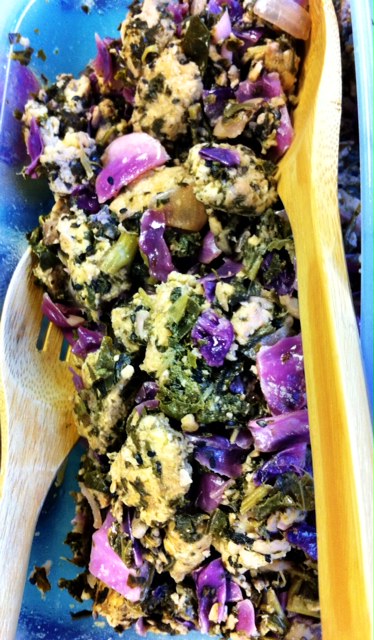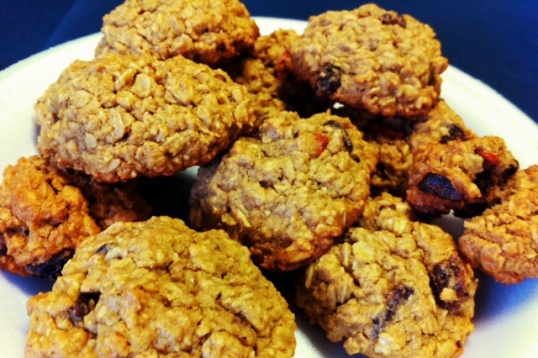Tempeh: Liver Blood Booster (and its sidekick, Cookies!)
Rounding out our week of the “Wrath of the Food Gods,” MI made a delicious meal for us–twice. (The first go-round was sacrificed to the Pavement deities after it decided it wanted to ride on the hood of her car). Luckily for us, second time was a charm and MI brought it a well-rounded assortment of Liver Blood boosting treats, including dessert! We also got to try good old fashioned molasses (“on a spoon” style) which seemed to divide our class quite equally (I myself am in the “Yay, Molasses!” camp). Her array of condiments proved deliciously well-suited and it was the first exposure to tempeh for many in the class.
TCM DOS: Liver Blood Deficiency
with Blood Stasis from Cold
Western Correlation: Dysmenorrhea and/or Irregular periods with Pain
Tongue: thin body, pale to purple, dry
Pulse: thin, weak; could be wiry or thready
SIGNS & SYMPTOMS:
Scanty and Irregular menstrual periods (LV Blood Deficiency) with large dark clots and severe pain (Blood Stasis from Cold)
Floaters, blurred vision, dry eyes, dizziness (LV Blood Deficiency)
Pale, Sallow Complexion, lips, and nails; also dry and brittle hair, skin, and nails (LV Blood Deficiency)
Cold Lower Abdomen with or without palpable cysts, fibroids, or lumps (Blood Stasis from Cold)
FOODS THAT HELP THIS CONDITION:
1) Liver Blood Deficiency: Chloryphyll-rich foods, microalgae, spirulina, wheat grass, leafy greens and sprouts (the darker and more freshly picked the better–kale, swiss chard, spinach), foods rich in iron and B12 , and cooked whole grains: rice, oats, roasted barley, sweet rice, spelt, millet, pumpkin, sweet potatoes, squash, carrots, corn, parsnips, yams, peas, stewed fruit, onions, leeks, garlic, turnip, mushrooms including oyster & shitake, spinach, chard, kale, chinese greens, beets, parsley, celery, lychee fruit, coconut, grapes (esp. raisins), cherries, blackberries, huckleberries, mulberries, black legumes in general, chick peas, black beans, kidney beans, fava beans, tempeh, chicken, beef, pork, Chinese black boned chicken, quail, goose, rabbit, frog, organic liver, pigeon, eggs, organic bone marrow, mackerel, tuna, anchovy, perch, eel, catfish, oysters, mussels, shark, shrimp, prawns, clams, seaweeds, fresh ginger, black sesame seeds, peanut, molasses, rice syrup, barley malt, dates, figs, sugar cane, wheat grass, miso, vegemite, marmite
Foods to Avoid for Liver Blood Deficiency: salads, raw fruits, sprouts, raw vegetables, excess amounts of tofu, dairy or nut butters and other high oil foods, overly sweet foods, refined sugars, high doses of vitamin C, stimulants like coffee, tobacco, and chocolate; cold foods like ice cream or smoothies, iced drinks including ice water
2) Blood Stasis from Cold: turmeric, basil, nutmeg, oregano, rosemary, white pepper, hawthorn berries, shallots, leeks, chives, garlic, ginger, taro root, eggplant, mushrooms especially wood ear mushrooms, aduki beans, chestnuts, kidney beans, crab, jellyfish, mussels, clams, sea cucumber, abalone, red wine (small amounts), kelp and other seaweeds, sugar cane, vinegar, rose water
Foods to Avoid for Blood Stasis from Cold: same as for Liver Blood Deficiency
—————————————————————————————————————-
Helpful Cooking Methods: Avoid Frying and Roasting, Light Steaming is best, Boiling is okay, but provides less nutrition
1) For Liver Blood Deficiency: In general it is best to eat foods that are lightly cooked to ensure that nutrients are preserved and are more readily digested and absorbed. General dietary recommendations to prevent deficiency include eating high quality proteins, lightly cooked vegetables and chewing meals thoroughly. Meals should emphasize leafy green vegetables, roughly 30% to 40 % of your diet and high quality protein sources, roughly 20% – 30% of you diet. The balance of the diet should center around complex carbohydrates, like whole grains and lightly cooked vegetables.
2) For Blood Stasis: meals should consist largely of lightly cooked vegetables, roughly 40% to 60% of your diet. About 30% of the diet should be comprised of complex carbohydrates. Proteins should comprise only about 10% of the diet, with a focus on high quality sources. The diet should also include plenty of fragrant and lightly spiced dishes. Highly processed foods and well as oily and fatty foods should be avoided.
——————————————————————————————————————-
Tempeh to Keep the Tempo
Ingredients:
2 eight ounce packages of Organic Tempeh cut into 16 pieces each or more
1 T. Braggs Liquid Aminos
3-4 T. Red Wine Vinegar or Apple Cider Vinegar
2-3 T. Olive Oil
1 cubic cm Ginger Root grated
1/2 cup Organic Shitake Mushrooms cut long-ways into thin strips, no stem
1-2 cup Hot Water
1/2 of a Large White Onion chopped
3/4 cup frozen Organic Kale (massage first and chop up if using fresh)
1/2 cup fresh Organic Baby Spinach
1/4 of a head of Organic Red Cabbage chopped (loosely)
1/4 tsp. Garlic powder or 1 clove minced garlic
1/4 cup Toasted Black Sesame Seeds
Preparation:
1) Marinate Tempeh in Olive Oil, Braggs, Vinegar, Ginger and 1/4 c. Shitake Mushrooms Steeped in Hot Water for ~ 5 min. first and added (with the water) for 2 hours or more (overnight would be best)
2) Pour Tempeh and Marinade in pan, add the Onion, and Sautee over medium heat for 5 minutes or so until the Onion is soft, then add the Kale and Spinach. Sautee for 5 more minutes until the Spinach and Kale are soft, but still vibrant. Add the Cabbage, remaining mushrooms (not steeped) and garlic to taste, stir, and cover for 15-20 minutes over medium-low heat, stirring 3 or 4 times. Mix in Toasted Sesame Seeds, leaving some to garnish.
3) Serve immediately or store and let the flavors develop further. Serve alone or with Sauer Kraut and Mustard of your choice, appropriate spices and seasonings.

Spirulina, blackstrap molasses, and Bragg's sea kelp delight--the cornerstone accoutrement of anyone deficient in Liver Blood.
——————————————————————————————————————
Thrice the Benefit Vegan Oatmeal Cookies
Ingredients:
3/4 cup Vegan Butter
1/3 cup Organic Raw Sugar (can be replaced by honey or Stevia or try applesauce or bananas, etc.)
3/4 cup Dark Brown Sugar (contains molasses)
1 tsp Organic Vanilla
1/2 cup Almond Milk
1 cup Organic Oat Flour
1/2 tsp Baking Soda
1/4 tsp Ginger Powder
1/4 tsp Cloves
1/2 tsp Cinnamon
1/4 tsp Nutmeg
3 cups Quick Cooking or Rolled Oatmeal
1/2 c. Organic Raisins
1/4 c. Organic Goji Berries
4-5 Large Organic Medjool Dates pitted and chopped
Preparation:
1) Cream together the Vegan Butter and Sugars until smooth. Add Organic Vanilla and Almond Milk and mix well.
2) Add Organic Oat Flour, Baking Soda and Spices until well mixed, then stir in Oats, Raisins, Goji Berries, and Dates.
3) Spoon 1 1/2 inch balls onto an ungreased cookie sheet and bake 10-15 minutes at 350 degrees, or until done– careful not to let them burn.
References:
Hackett, Jolinda. “Spiced Vegan Oatmeal Cranberry Cookies.” http://vegetarian.about.com/od/desertrecipes/r/oatcrancookies.htm
Liu, Jilin. Chinese Dietary Therapy. 1995.
Ni, Maoshing. Tao of Nutrition. 1993.
Pitchford, Paul. Healing with Whole Foods. 2003.
Saper, James. Traditional Chinese Dietary Therapy Factsheets. http://www.eastmountain.ca



